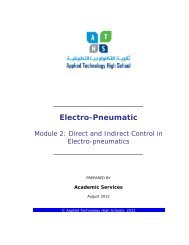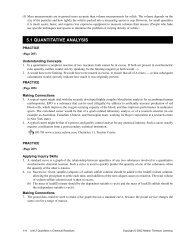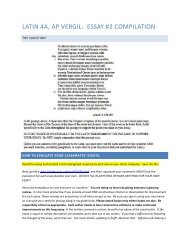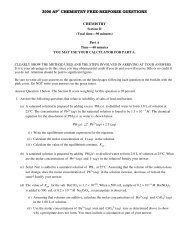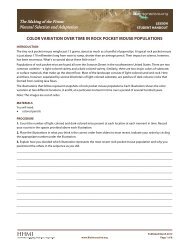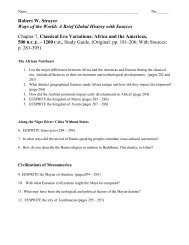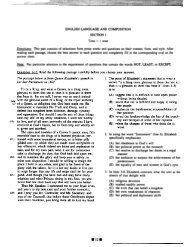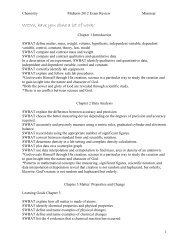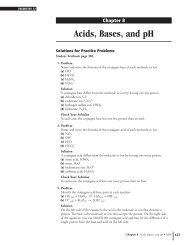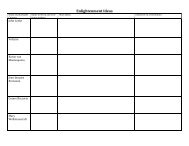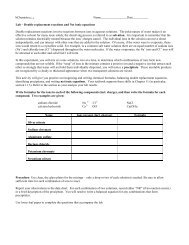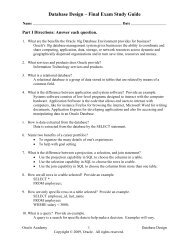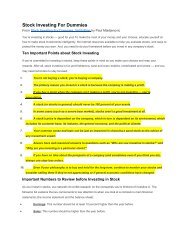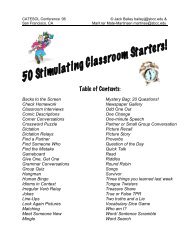The Great, Storied Study Guide and Answer Puzzler for the ... - Quia
The Great, Storied Study Guide and Answer Puzzler for the ... - Quia
The Great, Storied Study Guide and Answer Puzzler for the ... - Quia
Create successful ePaper yourself
Turn your PDF publications into a flip-book with our unique Google optimized e-Paper software.
<strong>The</strong> <strong>Great</strong>, <strong>Storied</strong> <strong>Study</strong> <strong>Guide</strong> <strong>and</strong> <strong>Answer</strong> <strong>Puzzler</strong> <strong>for</strong> <strong>the</strong> Government Final. Finally. <br />
STUDY GUIDE<br />
"It is a blind man who relies on recognition"<br />
-famous guy<br />
*******************************************************************************<br />
From Chapter 3:<br />
Please feel free to utilize your class work, notes <strong>and</strong> on-line text.<br />
What are <strong>the</strong> six principles of government?<br />
What are <strong>the</strong> two <strong>for</strong>ms of <strong>for</strong>mal amendment?<br />
Identify <strong>the</strong> second method of amendment <strong>and</strong> explain why it has never been utilized <strong>for</strong> proposal <strong>and</strong><br />
ratification.<br />
What articles correspond to <strong>the</strong> three branches of government <strong>and</strong> why?<br />
How are <strong>the</strong> states involved in <strong>the</strong> amendment process?<br />
Which involves <strong>the</strong> greater participation on behalf of <strong>the</strong> states <strong>and</strong> why?<br />
Identify <strong>the</strong> necessary <strong>and</strong> proper clause <strong>and</strong> explain why it was needed.<br />
Identify an "article" <strong>and</strong> explain what it does.<br />
Name <strong>the</strong> three types of government powers listed in <strong>the</strong> Constitution <strong>and</strong> explain what <strong>the</strong>y actually do<br />
<strong>and</strong> why <strong>the</strong>y are important.<br />
Explain how <strong>the</strong> Constitution is both loosely <strong>and</strong> strictly constructed <strong>for</strong> interpretation. Why is this<br />
necessary? In what way do both methods act toge<strong>the</strong>r to insure <strong>the</strong> efficient function of government?<br />
From Chapter Two:<br />
Early plans of government<br />
Weaknesses of <strong>the</strong> Articles of Confederation<br />
How were <strong>the</strong> Federalists able to persuade <strong>the</strong> Anti-Federalists to accept <strong>the</strong> new Constitution?<br />
<strong>The</strong> purpose of <strong>the</strong> Articles of Confederation as a constitution.<br />
What are <strong>the</strong> Bill of Rights? Why were <strong>the</strong>y added?
From Chapter One:<br />
Definitions of a state; purposes of government.<br />
<strong>The</strong>ories of government <strong>and</strong> Enlightenment thinkers.<br />
Systems of government <strong>and</strong> <strong>the</strong>ir differences--Federal ,Unitary <strong>and</strong> Parliamentary.<br />
<strong>The</strong> principles <strong>and</strong> ideals of American democracy.<br />
Short response question(s):<br />
Editorial Cartoons <strong>and</strong> W.A.V.E.<br />
Recall that <strong>the</strong> W.A.V.E. acronym st<strong>and</strong>s <strong>for</strong> :<br />
W-Words<br />
A-Actions<br />
V-visuals<br />
E-Emotions<br />
This is merely a methodology <strong>for</strong> symbolic representation, which is what a cartoon does,<br />
usually with <strong>the</strong> aid of labeling ,dialogue ,almost always some kind of action as well as a topic<br />
title.<br />
It is most certainly symbolic <strong>and</strong> exaggerated, usually with <strong>the</strong> use of caricature--poking fun or<br />
mocking <strong>the</strong> subject participants by grossly exaggerating <strong>the</strong>ir features <strong>and</strong> actions or portraying<br />
<strong>the</strong>m as something seen as ridiculous( a clown, <strong>for</strong> instance).<br />
On page I-18 in <strong>the</strong> front of <strong>the</strong> text <strong>the</strong>re is a section entitled Analyzing Political<br />
Cartoons. This does a fine job of taking you through <strong>the</strong> steps of application, utilizing a cartoon<br />
<strong>for</strong> <strong>the</strong> process. Elsewhere <strong>the</strong>re are innumerable examples of methodology on <strong>the</strong> internet.<br />
You will have a cartoon to analyze, <strong>for</strong> a particular perspective. It may or may not be one you<br />
have seen be<strong>for</strong>e.
Extended response :<br />
It is important to answer all of <strong>the</strong>se as completely as possible. Identify what needs to be<br />
answered directly. Is <strong>the</strong>re more than one part to a question? Start by providing definitions, <strong>the</strong>n<br />
write <strong>the</strong> functions required. Now look back <strong>and</strong> determine if you have been clear. Have you<br />
provided topic sentences? A conclusion? Did you provide transitional phrases or words? If you<br />
do not do <strong>the</strong>se things, you are merely identifying <strong>and</strong> listing as opposed to providing an<br />
explanation. <strong>The</strong>re is a big difference. <strong>The</strong> explanation provides <strong>the</strong> extent of your knowledge by<br />
<strong>the</strong> in<strong>for</strong>mation you have provided <strong>and</strong> how well you explain relationships-recall <strong>and</strong><br />
comprehension <strong>and</strong> application..<br />
Remember when you write, it is a good idea to write down some brief points first; try <strong>and</strong><br />
organize your thoughts.<br />
Recall that some of <strong>the</strong>se questions are directly from your PowerPoint notes( a very good reason<br />
to take <strong>the</strong>m seriously); one of those will be your required question.<br />
<strong>The</strong>re will be one required question from <strong>the</strong> list below; <strong>the</strong> o<strong>the</strong>r (your choice) will come from<br />
<strong>the</strong> remainder. <strong>The</strong>re<strong>for</strong>e, it is suggested <strong>for</strong> brevity's sake that you answer all of <strong>the</strong>m so that<br />
you are prepared.<br />
a) Name <strong>the</strong> three types of government powers listed in <strong>the</strong> Constitution <strong>and</strong> explain what <strong>the</strong>y actually<br />
do <strong>and</strong> why <strong>the</strong>y are important.<br />
b) Identify <strong>the</strong> necessary <strong>and</strong> proper clause <strong>and</strong> explain why it was needed.<br />
c) How are <strong>the</strong> states involved in <strong>the</strong> amendment process? Explain <strong>the</strong> steps involved <strong>and</strong> why it has<br />
never been utilized as an alternative.<br />
d) Identify <strong>the</strong> essential parts of <strong>the</strong> Constitution <strong>and</strong> explain how <strong>the</strong>y have worked toge<strong>the</strong>r to preserve<br />
it as a workable blueprint <strong>for</strong> government <strong>for</strong> over two hundred years.<br />
e) Compare <strong>and</strong> contrast <strong>the</strong> strengths of <strong>the</strong> Articles of Confederation <strong>and</strong> <strong>the</strong> Constitution.<br />
f) Compare Hobbes to Rousseau. Identify <strong>the</strong>ir position or views -- how <strong>the</strong>y are alike <strong>and</strong> different-- <strong>the</strong>n<br />
explain , in your opinion, which of <strong>the</strong> two is more accurate about <strong>the</strong> nature of man <strong>and</strong> <strong>the</strong> institution of<br />
government.
GOVERNMENT-‐ UNIT TWO EXAM <br />
1. STUDY GUIDE<br />
2. know examples of all powers <br />
3. expressed power <br />
4. supremacy clause <br />
5. implied powers <br />
6. inherent powers <br />
7. federal m<strong>and</strong>ate <br />
8. <strong>the</strong> role of committees in Congress <br />
9. congressional districting <strong>and</strong> apportionment <br />
10. investigatory powers <br />
11. checks <strong>and</strong> balances <br />
12. non-‐legislative powers of congress <br />
13. definition of federalism <br />
14. House leadership <br />
15. appointments to <strong>the</strong> senate <br />
16. nullification doctrine <br />
17. ex post facto <br />
18. bill of attainder writ of habeas corpus <br />
19. full faith <strong>and</strong> credit clause <br />
20. how a bill becomes a law in <strong>the</strong> House <br />
21. strict <strong>and</strong> loose constructionists <br />
22. rider <br />
23. <strong>the</strong> differences between joint <strong>and</strong> concurrent resolutions <br />
Make sure you provide full descriptions <strong>and</strong> details in your extended responses. <br />
One extended response will be required; you may pick <strong>the</strong> o<strong>the</strong>r one. <br />
UNIT 3 TEST STUDY GUIDE <br />
1. In case <strong>the</strong> President is disabled, <strong>the</strong> way <strong>the</strong> Vice President becomes President is determined by <strong>the</strong><br />
2. As of January 20, 2001, <strong>the</strong> President receives a yearly salary of<br />
3 If an incumbent President is seeking ano<strong>the</strong>r term in office, who will his party likely nominate?<br />
4. A State's presidential electors are chosen by<br />
5. A President can serve no more than ___ years in office.<br />
6. According to <strong>the</strong> Presidential Succession Act of 1947, which of <strong>the</strong>se officers follows <strong>the</strong> Vice President<br />
in <strong>the</strong> line of presidential succession?<br />
7. <strong>The</strong> least number of presidential electors a State can have is
8. A <strong>for</strong>mal duty assigned to <strong>the</strong> Vice President by <strong>the</strong> Constitution is to<br />
9. <strong>The</strong> first <strong>and</strong> most widely publicized caucus today is held in <strong>the</strong> State of __________.<br />
10. <strong>The</strong> most widely supported plan <strong>for</strong> re<strong>for</strong>m of <strong>the</strong> electoral college is <strong>the</strong> ________.<br />
11. Characteristics that usually determine who is nominated <strong>for</strong> President<br />
12 Formal qualification <strong>for</strong> <strong>the</strong> presidency? In<strong>for</strong>mal?<br />
14 One of <strong>the</strong> major flaws in <strong>the</strong> electoral college system is that…<br />
15 How many justices does <strong>the</strong> Supreme Court have today?<br />
16. <strong>The</strong> written arguments of each side to an appeal are called<br />
17. What is a writ of certiorari? <br />
18. Who holds <strong>the</strong> power to impeach a federal judge? <br />
19. Which term refers to previous court rulings?<br />
20. What refers to cases that fall under both federal <strong>and</strong> state jurisdiction?<br />
21. <strong>The</strong> court that first hears a case is said to have <br />
22. <strong>The</strong> list of cases to be heard by a court is called a<br />
23. Which of <strong>the</strong> following could be <strong>the</strong> subject of a criminal case tried in federal court?<br />
24. Which of <strong>the</strong> following is a TRUE statement about a writ of certiorari?<br />
25. Most importantly, <strong>the</strong> Supreme Court is called <strong>the</strong> High Court because it is <strong>the</strong><br />
26. <strong>The</strong> Supreme Court's decision in Marbury v. Madison<br />
27. A federal court has jurisdiction over a case if<br />
28. Jurisdiction DIRECTLY limits what?<br />
29. <strong>The</strong> independence of <strong>the</strong> judicial branch is ensured by <strong>the</strong><br />
30. Arguments against <strong>the</strong> Electoral College<br />
Chapter 6 all<br />
Ch.8 sec 1 vocab on p.<br />
COVERAGE
Know basic structure of courts ,p.222<br />
Ch 8 all of sec 3 including vocabulary<br />
5 influences on court<br />
difference between majority <strong>and</strong> concurring opinion<br />
term of session<br />
case average<br />
How a Supreme Court decision is reached<br />
Supreme Court cases <strong>for</strong> extended response<br />
Be able to discuss <strong>the</strong> facts of <strong>the</strong> case<br />
know <strong>the</strong> arguments<br />
know <strong>the</strong> outcome(ruling)<br />
know <strong>the</strong> significance<br />
Extended response<br />
Marbury vs. Madison<br />
McCulloch vs. Maryl<strong>and</strong><br />
Plessey vs. Ferguson<br />
Gideon vs. Wainwright



